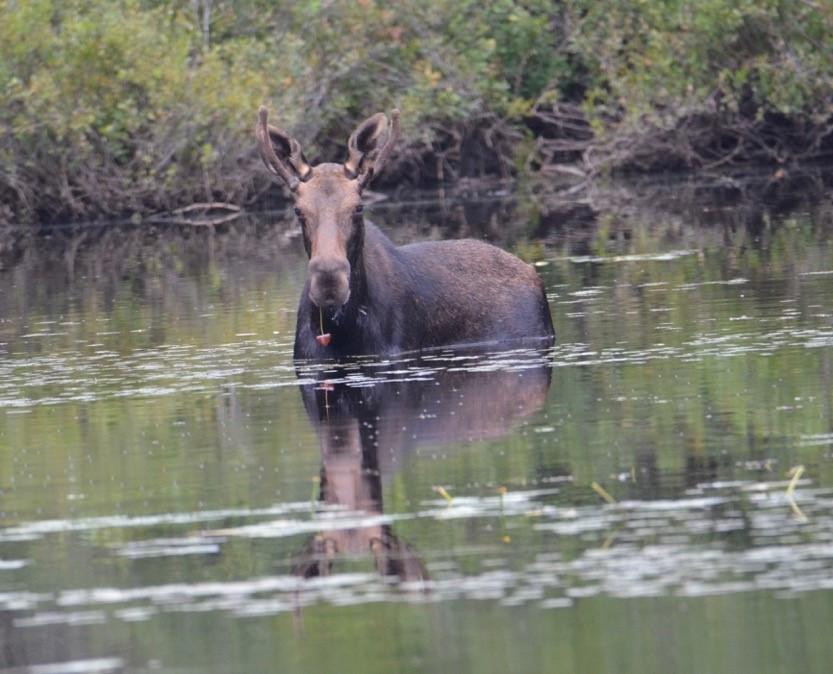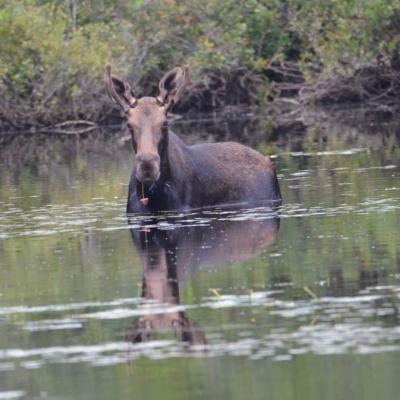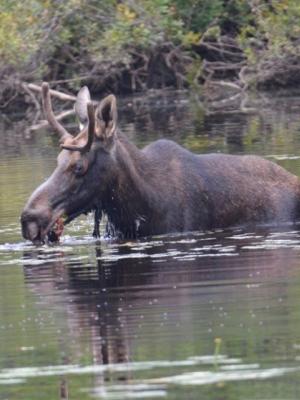- Tags:
- Wildlife

A young bull moose belly deep in Pickerel Pond while eating water lilies on Tom Thomson's Orford, NH, Tree Farm
It's been a HOT summer in New Hampshire. Statewde meteorologists track an average of 12 days of daytime high temperatures exceeding 90F degrees at the Concord, NH, weather reporting station. Summer of 2020 doubled that to 24 days of temperatures exceeding 90 degrees thus far. While people flocked to water in summer to cool off, for moose, wading is standard operating procedure each summer. Moose seek shallow lakes, ponds and wetlands where they feed on aquatic plants for the mineral sodium concentrated in these emergent and submerged plants.

Tom Thomson recently shared photos of a young bull moose grazing on aquatic bullhead pond lillies in Pickerel Pond on his Orford, NH, Tree Farm.
The summer aquatic plant diet of North American moose (Alces alces) is linked to the need to obtain sodium. Studies by wildlife biologists on the Copper River Delta in Alaska cite moose habitat preferences, seasonal diets, forage abundance and quality and population surveys indicating emergent plants in small shallow ponds are particularly important to moose populations.
While sodium is available in woody plant diet of leaves, twigs, and buds, the emergent or submerged aquatic plants produce an average of four times more nutrition than terrestrial plants. Aquatic plants are more digestible and have higher concentrations of minerals than woody forest browse more typical winter moose diet. The etymology of the word "moose" is from the Native Algonquin language and translates roughly to "twig eater."
Both male and female moose seek shallow aquatic habitat provided by wetlands and shallow ponds and edges of larger lakes to forage on super-nutritious aquatic vegetation. Beaver ponds are a particularly important landscape feature, providing sunny, open expanses of shallow water with mucky bottoms favored by these aquatic plants in an otherwise heavily forested landscape. If you think about the frogs, turtles, spotted newts, wood ducks, hooded mergansers, wading great blue herons and moose that benefit from beaver-created wetlands, you'll understand why beavers are considered a keystone wildlife species creating and maintaining habitats for myriad other species of NH wildlife.

In NH, moose breed in October during the annual "rut." By early winter, moose migrate from ponds and shallow lakes located in river valleys moving uphill into young forests that provide ready access to the woody twigs and buds of sapling trees as well as the bark of understory trees. Forestry operations including sunny, open clearcuts and larger patch cuts are particularly imporant for providing winter moose habitat. Older, mature forest habitats with dense shade under closed canopy conditions do NOT provide moose access to sprouting stumps, young saplings and tender bark of younger trees - the preferred winter diet for moose. Red maple and striped maple trees in particular are heavily favored as winter browse. Hikers often find parallel browsing "scrapes" made by the lower incisor teeth of moose in the bark of young trees in the forested settings where moose overwinter.
Winter moose scrapes from browsing young trees are distinctly different from more ragged antler "rubs" created by buck deer removing velvet from antlers and leaving territorial scent marks. Bull moose territorial scent marking during their October rut breeding season is accomplished with muddy, "moose muck" pits where male bulls and female cow moose wallow and urinate to leave territorial scent messages to attract mates. Understanding moose seasonal habitat preferences can increase your own chances of glimpsing a moose from a safe distance when hiking in northern New Hampshire's forested landscape.
Thanks for these great moose photos, Tom!

